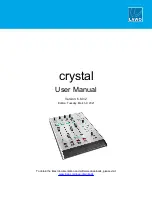
1
Standard apertures
There is a wide range of practical apertures to select from:
micro spot, small spot, large spot, fixation, slit and cobalt
blue filter. A red-free filter is also available for use on the
apertures. This selection of apertures covers all the
physician’s needs in an ophthalmologic examination.
A. Micro spot aperture: Allows quick visual entry in very
small, undilated pupils.
B. Small aperture: Provides easier view of fundus through
an undilated pupil. Always start examination with this
aperture, proceed to large aperture as pupil adapts to light.
C. Large aperture: Standard aperture for dilated pupil and
general examination of the eye.
D. Fixation aperture: The pattern of an open center and
thin lines permits easy observation of eccentric fixation
without masking the macula.The graduated cross hairs can
be used to estimate either the amount of eccentric fixation
relative to the macula or the size or location of a lesion on
the retina or choroid.
NOTE: When viewed outside the patient at a distance less
than 40", the fixation aperture will be out of focus. The lens
of the eye will insure correct focus on the fundus.
E. Slit or streak: Helpful in determining various levels of
lesions, particularly tumors and edematous discs.
F. Cobalt blue filter: When fluorescein dye is injected into
the vein of a patient, the physician can observe the
movement of this fluid within the vessels. When viewed
through the cobalt filter of the ophthalmoscope, the dye will
appear as a yellow/green color. If any vessel is abnormal,
leaking or hemorrhaging, the cobalt filter will reveal this
problem. Flourescein drops in the eye may also help
detect corneal abrasions and other lesions.
Other filters
Welch Allyn ophthalmoscopes #11720 and #11730 are
equipped with a unique sliding switch that greatly increases
their versatility.
• Ophth Broch ForeignWorking.2 4/26/99 1:02 PM Page 1




































